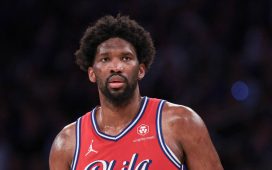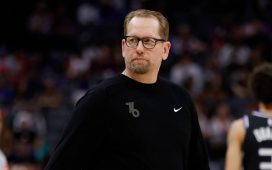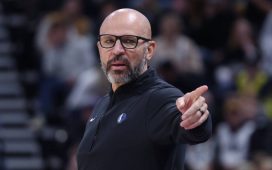As the Minnesota Timberwolves mulled one of the biggest trades in franchise history, as they contemplated making a move everyone in the organization understood would be hotly debated across the league, one question crystallized the situation and ultimately convinced them to pull the trigger on a massive swing for Rudy Gobert.
What are we waiting for?
They looked around at the rest of the Western Conference and knew they were not good enough. Last season’s team was young and fun and exciting and the revival of Minnesota as a basketball market was rewarding. But the overwhelming feeling internally was that if they didn’t make some significant maneuvers, a team that had squeezed every ounce of success possible out of its roster was destined to hit a wall in a conference that is only getting tougher and deeper.
There they sat with a budding star in Anthony Edwards, a rejuvenated franchise player in Karl-Anthony Towns and a head coach in Chris Finch who has command of the room and the security of a long-term deal. So they could sit back and let Ant and Jaden McDaniels develop gradually, watch KAT continue to mature as a leader and hope that D’Angelo Russell played inspired ball as he entered a contract year. They could cross their fingers that Patrick Beverley stayed healthy, Malik Beasley kept his head on straight and rookies Walker Kessler and Wendell Moore Jr. were ahead of the development curve. They could hold the fort for another season, see how all of that panned out, and if it didn’t work, head into the summer of 2023 with max salary cap space and make their move then. That was the safe move.
Tim Connelly, who is less than two months into a five-year contract as president of basketball operations, didn’t have to show any urgency. He could afford to observe this team, immerse himself in the chemistry of the group and wait until February to look at making wholesale changes.
Or … they could pounce. The Utah Jazz made it known that they were looking to make changes to their Gobert-Donovan Mitchell core after a disappointing season. The Timberwolves’ biggest priority after the Memphis Grizzlies outlasted them in the first round of the playoffs on the strength of Ja Morant’s fourth-quarter drives to the basket and Brandon Clarke’s relentlessness on the offensive glass was to address rim protection and rebounding. There is not a better rebounder or rim protector in the league than Rudy Gobert.
They knew all the concerns. Yes, Gobert is due $170 million over the next four seasons. Yes, the supersized frontcourt pairing with Towns is unconventional in the age of the wing scorer. Yes, the Jazz’s sputtering in the playoffs has led to doubts about Gobert’s ability to control games in the postseason the way he does in the regular season.
As Connelly and the Timberwolves decision-makers, including holdovers Sachin Gupta, Manny Rohan and Finch and newcomers Matt Lloyd and Dell Demps, looked at the rest of the league, they had difficulty identifying a player that could be had for the package they were prepared to offer that covered up so many of their team’s weaknesses. They tried to picture what that series with Memphis would have looked like with Gobert there to keep Morant out of the paint and dwarf Clarke on the boards. They thought about how Russell’s life would have been so much easier with Gobert setting screens for him and offering a lob threat on the pick-and-roll while Russell sized up the drop coverage that he is so comfortable attacking. They thought about Edwards gambling even more on defense knowing that Gobert had his back if he got beat.
And they also thought about how much they could help Gobert. With McDaniels and Edwards, who showed significant improvement as a defender as his second season progressed, the Wolves have two perimeter players who won’t be turnstiles and force Gobert to guard the entire court all by himself, as happened in Utah last season. Towns’ shooting will complement Gobert’s interior presence, and the sheer wing span of a starting five that doesn’t have a player under 6 foot 4 could make a Gobert-anchored group much more sustainable than the smoke-and-mirrors scrambling the Wolves parlayed into a surprising 13th-ranked defensive rating last season.
Given all that, and the third-year leap they anticipate from Edwards, the stability they hope will bring even more out of Towns and the belief that it would be hard to find another star player who is open to Minnesota the way Gobert was — sources told The Athletic that Gobert expressed excitement about the opportunity of playing with the Timberwolves and that Towns, in particular, was supportive of the move — that one question just kept gnawing at the group while they labored over the decision.
What are we waiting for?
With owners Glen Taylor, Marc Lore and Alex Rodriguez firmly behind the idea, the Timberwolves pulled the trigger on a blockbuster. They sent Beverley, Beasley, Jarred Vanderbilt, Leandro Bolmaro and the draft rights to Kessler, plus unprotected first-round picks in 2023, 2025 and 2027, a pick swap in 2026 and a top-five protected first-rounder in 2029 for Gobert, the three-time NBA Defensive Player of the Year.
Lore and Rodriguez, the two friends who are scheduled to take over majority control of the Timberwolves at the end of 2023, have been aggressive since joining the organization. They spearheaded the recruitment of Connelly to lead their front office, wanting an experienced executive to push a team that doubled their win total from the previous season into regular contention in the West. They encouraged Connelly to be bold in his maneuvering and it is hard to imagine a more audacious bet.
The enormity of the price tag cannot be overstated.
- Beverley was invaluable last season in changing the culture in Minnesota. But he was on a one-year deal and a move to the bench was likely coming next season.
- Beasley is one of the league’s best volume 3-point shooters. But he has a history of off-the-court issues and the Wolves wanted to create room for Jaylen Nowell.
- Vanderbilt was the engine of the team with nonstop hustle and an inspiring return from foot issues in college. But retaining him in a deal for Gobert would have reduced the offensively-challenged Vanderbilt to no more than a bit role in the frontcourt rotation.
- Kessler was the 22nd overall pick in the draft last month and a player the Wolves are very high on. But the Jazz needed another young player to justify giving up a Hall of Fame-level center.
- Bolmaro was a first-round pick in 2020 but had no path to playing time with the Timberwolves.
- The draft pick compensation is along the lines of what superstars Anthony Davis and Paul George fetched. But the Wolves chose to up the ante there rather than part with the up-and-coming youngster McDaniels.
Sources told both Jazz writer Tony Jones and me that Danny Ainge pushed hard to include McDaniels. Earlier versions of Utah’s ask included the four first-rounders, McDaniels, multiple pick swaps and some second-round picks as well. The Timberwolves held firm in refusing to include McDaniels, a versatile defender who blossomed under the glare of the playoff spotlight against Memphis and is entering his third season in the league.
In the days immediately following Connelly’s hire, multiple sources told The Athletic, the new leader of the front office started to ponder the possibility of adding Gobert to the core he inherited. The rumblings about a shakeup in Utah had been prevalent all season long, and the Timberwolves were growing more and more open to the idea of moving Towns, who played center his first seven seasons, to power forward and finding a center who could take the rim-protecting pressure off of him.
The Wolves started trying to talk to the Jazz about Gobert the week of the draft, but Ainge is known for being a stickler in negotiations and was driving a hard bargain. As blockbuster deals often do, there were twists and turns, stops and starts. Word started to circulate on Thursday evening that there was progress being made toward a Gobert deal, but Wolves sources were pessimistic almost the whole way through.
By Friday morning, sources said, the deal was in peril. Both sides were sticking to their guns and the Timberwolves started to look hard at other available rim protectors. In addition to Gobert, they had been linked to Indiana’s Myles Turner and Atlanta’s Clint Capela in previous reporting. The Wolves also made several calls to Brooklyn on Kevin Durant, sources said, but the Nets were asking for established All-Stars and a mountain of picks. Minnesota was unwilling to part with either Edwards or Towns in a KD-centered deal, so there was no traction. Had they gotten more aggressive with San Antonio in talks for Dejounte Murray, they could have outbid Atlanta. But they didn’t, making it clear that they always valued Gobert more.
Later Friday morning, the talks started to pick up steam again, and Utah was amenable to greater draft pick compensation to leave McDaniels out of the deal. Lore and Rodriguez wholeheartedly endorsed a move that almost assuredly will mean the Wolves are paying the luxury tax over the final two years of the deal. Taylor was all in as well, envisioning sustained team success in the waning years of his ownership.
The Wolves are making this deal in the hopes that it helps maximize both of their best players. Towns will be free to roam and may avoid foul trouble that plagued him in recent seasons and will probably result in him returning to more of a volume 3-point shooter. For only the second time in his eight seasons, Towns will enter the season with real expectations.
Edwards can run pick-and-roll with Gobert all day long and feast in transition when Gobert ends possessions with a blocked shot or rebound. And Connelly’s additions of veteran Kyle Anderson, who came before the Gobert deal, and Bryn Forbes, who was locked in on Friday night to help account for the loss of Beasley’s shooting, fit beautifully with this new look.
Ultimately, the Wolves looked at the West, looked at the ceiling of their current group and looked at a Hall of Fame defender and someone they view as one of the 20 best players in the league and went for it. They targeted Gobert for weeks and got him without giving up McDaniels. They view it as a massive win, regardless of the price.
Utah!!! I was just a kid from France when i got here 9 years ago… pic.twitter.com/TKmQ6tC4dH
— Rudy Gobert (@rudygobert27) July 2, 2022
The Wolves understand this is a polarizing move. For all of Gobert’s acclaim as a defender, the Jazz never were able to make a conference finals with a Gobert-Mitchell core. Utah routinely posted elite defensive metrics in the regular season with Gobert leading the charge but wasn’t able to sustain that level in the playoffs against teams that could go small and move the ball. He has never averaged even 16 points per game in a season and has taken 11 3-pointers in nine seasons.
The Timberwolves are the only team in the league with two players on contracts worth more than $200 million, and they’re both big men. This unique roster construction comes in the wake of fans watching Golden State and Boston, two teams driven by wings and guards, square off in the NBA Finals.
And by the time Edwards is up for a (presumed) max contract extension in 2024-25, the Timberwolves will be pouring more than $93 million into their frontcourt. Luxury tax, here they come. When a team delves into the tax for an extended period, as almost every team that enters true contention must do, rounding out the roster with cheap talent mined from the back half of the first round is important, especially in a market that historically has struggled to attract free agents. It’s one of Connelly’s calling cards, the ability to identify talent and develop it on draft picks that land outside the lottery. Now, the Wolves are going to be missing some real chances to bolster their depth.
If this works like the Wolves believe it can, if Towns can keep up defensively against power forwards and Gobert can do enough at the rim on offense to punish opponents for going small, Minnesota will be picking in the 20s for quite a while. There are good players to be had down there. Gobert was pick No. 27 in 2013 and McDaniels was 28th in 2020. The Wolves found out just last year what can happen when a team assumes draft picks will be at the bottom of the first round, but things go wrong. But for a franchise that has been out of the first round of the playoffs exactly one time in its 33-season existence, it was a risk worth taking to try to build a team that can be a consistent contender in the Western Conference.
Will the Gobert trade bring a championship to Minnesota? That’s a tall order that probably depends more on Edwards’ development and Towns’ maturation than it does anything else. What it does do is make the Timberwolves dramatically better than they were last season, something they knew had to happen for them to avoid the kind of buzzkill season that hit the Hawks and Knicks after their surprising runs to the Eastern Conference playoffs in 2021.
Edwards is 20 years old and preparing for his third NBA season, which is often when a star leaps onto the stage. Towns is 26 and firmly in his prime, now armed with a $220 million-plus extension and coming off of the best season of his career. Gobert is 30, with 49 career playoff games on his resume and arguably more talent around him than he has ever had.
It is unconventional, but the Timberwolves decided they needed to be unconventional to give themselves a chance. Injuries could derail it. Egos could as well. What the Timberwolves believe is that they weren’t going to out-small ball Golden State. They weren’t going to outrun Memphis or outsmart Phoenix. They weren’t going to out-recruit the Lakers for free agents. They’re going to start big and they are going to stay big and see if the rest of the league can handle them.
Forever, the Wolves have been an afterthought or even worse, a punchline. This may work and it may not, but now they are too big to ignore.
They are not going to wait for Ant to enter his prime. They are not going to wait for another star that may be a more conventional fit for the roster to become available. They are not going to wait to see if KAT is ready to shoulder the burden in the playoffs.
Next season, the Timberwolves will be one of the league’s most fascinating experiments. The price they paid represents a considerable risk and who knows how they will handle the increased expectations.
What we know right now is this: the waiting in Minnesota is over.
Related reading
Jones: Jazz wanted a big return for trading All-Star Rudy Gobert, and they got it
Harper: Grading the Rudy Gobert trade: Who won — Timberwolves or Jazz?
(Photo of Rudy Gobert and Anthony Edwards: Hannah Foslien / Getty Images)






